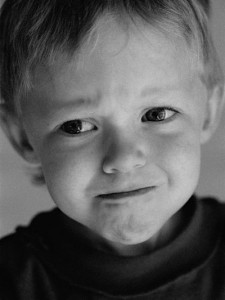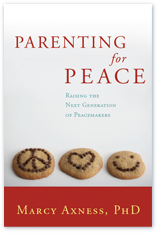
Yes, that’s really Ian!
Yes, I spanked my son. It was almost twenty years ago but I still remember it vividly. Ian was six or seven and was stubbornly, defiantly ignoring me right to my face. (About what? Now that I cannot recall!) Something primitive inside me uncoiled and I was suddenly spanking him. I regretted it immediately and ever since — not just for the obvious reason of having been violent with him, but also for the sliver of his respect I lost in that moment.
We lose the admiration of our children when we “lose it.” It’s a mammalian thing: all animal behaviorists know that our ability to have authority over — and thus the ability to train — a dog or a horse is severely eroded if the animal sees or feels us get angry. Credible leaders don’t lose their composure, it’s as simple as that. Of course children aren’t dogs, but we can learn so much from understanding the mammalian similarities! Our children’s respect and admiration are among the most potent tools in our parenting toolbox, and if we do things to erode them, we set ourselves up for trouble down the line.
There is also the approach to spanking in which the parent is not “out of control” but rather very much in control. They deliver the spanking in an almost matter-of-fact way that makes clear it is merely a consequence for the child’s behavior. It isn’t drenched in the parent’s anger or upset. This style is almost chilling in its use of force: rather than an act of passion (which even in a court of law will reduce an offender’s charge), it is a premeditated act (which in that same court can get you life).
Spare the Rod, Spoil the Child
This is a quote that is often mistaken as having come from the bible (which it doesn’t — it is a paraphrase of Proverbs 13:24). The most effective interpretation of this admonition is one in which the shepherd’s rod is used not to hit but to guide errant sheep in the right direction when they stray off the path. Just as sheep aren’t plotting to annoy the shepherd when they stray, the young child’s brain simply isn’t equipped to marshal the kind of complex planning and detailed motivational linkages that would enable her to systematically drive you crazy (much as it may sometimes seem like it).
Children need guidance and instruction, not punishment. And it is often far more effective to simply use a gentle, redirecting arm around the shoulder of a young one heading towards trouble — while perhaps also singing a soothing little melody, like the Pied Piper — than to deploy a string of words to reason with or explain (“…for the umpteenth time!”) the prohibition to the errant child.
What truly will spoil the child — that is, inhibit healthy brain development — is any kind of “disciplinary” measure that elicits a cascade of stress hormones in the child’s nervous system. Even just the threat of some of our conventional measures — a spanking, a time-out, even a parent’s disgusted look — can instantly shift a child’s biochemistry out of flourishing growth mode and into protection mode. Every time a child receives a punitive rebuke or scolding, it’s like a small shock to her system. (I mean, imagine yourself, today, receiving sternly delivered negative feedback about something you did. It is the rare person who can hear that without feeling a tightening in the stomach or a flush in the cheeks — and we’re adults, supposedly possessed of all our state-regulation neural software!)
Self-Regulation and Success
One of the keys to an individual’s success in any area of life — in school, in relationships, in business — is their ability to regulate their own internal states. This includes things like appetite, attention, emotions, thoughts, and everything else related to one’s inner life. Scientists have found that the prefrontal cortex area that governs self-regulation depends on the quality of our early relationships for its healthy development. That usually means relationship with parents, first and foremost.
A child’s self-regulation capacities wire up to match the relationship experiences she encounters. When her “misbehavior” is repeatedly met with forms of punishment that engage her stress system over  months and years, her response to these kinds of “relational concussions,” is to erect protective inner barriers that become increasingly difficult for parents (or anyone) to broach. How many times have we heard the parental lament, “I just can’t seem to get through to her!”?
months and years, her response to these kinds of “relational concussions,” is to erect protective inner barriers that become increasingly difficult for parents (or anyone) to broach. How many times have we heard the parental lament, “I just can’t seem to get through to her!”?
“Misbehavior” is a trap of a concept in the first place — a term only appropriate for situations in which someone truly understands the alternatives and consciously chooses to engage in bad behavior. But for the young child, this is simply not the case. The young child is a scientist figuring out the world, gathering data and conducting experiments. Her behaviors that don’t please us are more helpfully considered as “mistakes” rather than misbehavior. Do we punish people for mistakes? Not if we want improvement, excellence and growth!
Why Spanking Doesn’t Work
Not only am I devoted to parenting with peace in mind, I am a pragmatist. I’m a fan of doing what works, and not doing what doesn’t work. Spanking doesn’t work.[1] Any perceived effectiveness of swatting, slapping or spanking is nothing more than short-term compliance rooted in a child’s fear of the parent. This is a hallmark of the authoritarian style of parenting — in which children’s unquestioning obedience is the goal — rather than authoritative parenting — marked by the parents’ decisive yet respectful leadership role and an ever-deepening bond of loving trust between them and their children.
Rather than internalizing any moral message or noble value by being spanked, a child grows resentful and avoidant of the parent. This, together with such inner contortions of denial and dissociation that the child performs, exacts a steep, enduring toll on the child’s lifelong wellbeing. Spanked toddlers are less likely to listen, are less compliant and have more poorly developed motor skills; spanked adolescents are more likely to suffer depression, alcohol addiction and suicidal thoughts. Children who are hit are more likely as adults to hit their partners and their own children — and so it goes, the transgenerational-go-round of violence, which ripples outward from family to community to society. In Parenting for a Peaceful World, Robin Grille writes,
The school bully or juvenile delinquent is an emotionally injured individual trying to compensate for an inner feeling of powerlessness. The same is true for those who grow up to become autocrats, dictators and bullies in business. …Bullies are not a fact of life but an artifact of history.[2]
Spanking Alternatives That Do Work
 Even the most suspiciously flagrant “mistake” of a young child reflects an unmet need. Figuring out what that need is, rather than focusing on the inexperienced way the child expressed the need, or ineffective strategy he used to meet his need, is central to parenting success and peace in the home.For example, “stealing” a piece of your jewelry or some other precious item — yes, even your money — can be a child’s way to get close to you, to “keep you with him.”
Even the most suspiciously flagrant “mistake” of a young child reflects an unmet need. Figuring out what that need is, rather than focusing on the inexperienced way the child expressed the need, or ineffective strategy he used to meet his need, is central to parenting success and peace in the home.For example, “stealing” a piece of your jewelry or some other precious item — yes, even your money — can be a child’s way to get close to you, to “keep you with him.”
Hitting or teasing another child is also sometimes a young, inexperienced human’s misguided strategy to connect. And yet that same behavior — hitting, or even biting — will be used by another child (or the same child in a different circumstance) as an attempted strategy for meeting an entirely different need, such as the need to feel less fearful, embarrassed, isolated, or envious.
Waldorf kindergarten teacher Barbara Patterson[3] shares some wonderfully unexpected, lovely and effective healing approaches to such things as hitting and biting — which can evoke strong feelings, and sometimes (as in my incident with Ian) result in reactive, unmindful responses by parents. Having some creative responses at the ready can help us maintain the calm, loving authority children so need from us. Here are some healing actions for unacceptable behavior:
Violent / destructive play: Real, constructive work is the cure for violent play: digging holes or moving stones in the garden, moving furniture inside, carrying wood, stacking bricks.
Defiance: Between ages two and four, children can be very stubborn, and it’s best to simply overlook some of their negative reactions (remember, they’re always imitating!). Just go with the child and begin doing with him what you want him to do, without anger or lots of explaining. Don’t waiver or allow him to wriggle out of it. For example, rather than butting heads about him picking up his toys, just begin rhythmically picking up a toy or two and putting them into the bin. Like with a yawn, he will hardly be able to keep himself from joining in.
“Tattling” and other upsets with socializing: Chronic problems in this area suggest difficulties or weakness in the child’s developing social brain / will energies. Involve her in your work, to let her feel the adult’s creative strength focused upon a particular activity. Washing dishes is a wonderful healing action here, as is baking. Sometimes merely listening to children’s upset or tears will ease up the problem enough so that they can respond to a suggestion as simple as, “Just go start over.”
[1] Grille, Robin. Parenting for a Peaceful World. NSW, Australia: Longueville, 2005. See pg. 181-191 for a thorough discussion of the topic of corporal punishment.
[2] Grille, Robin. Parenting for a Peaceful World. NSW, Australia: Longueville, 2005, pg. 187.
[3] Patterson, Barbara, and Pamela Bradley. Beyond the Rainbow Bridge: Nurturing Our Children from Birth to Seven. Amesbury, MA: Michaelmas Press, 2000. Many of the discipline insights and ideas in this step are inspired by this lovely book, for which I’m grateful to Barbara and Pamela.
Tags: brain development, imitation, spanking



Dear Marcie,
Thank you for this very instructive article. I know this is designed for parenting, however I wonder if you could sort of ‘reverse engineer’ it to answer a question… For someone who grew up with what you are not advising in this article and had this treatment extended into adulthood due to health concerns and resultant lack of independence could you offer any thoughts for healing/retraining those biochemical cascades and sort of changing the effect of the punishing and negative home training? I know people are remarkably capable of learning and healing. Also any thoughts on how to deal with family members who continue these negative stressful behaviors if one has not had the opportunity to go somewhere more supportive… Thanks for any thoughts you wish to share. You may email should you want to.
Dear Marcy,
I loved this article just wish I had it 37 years ago when my children were tiny.